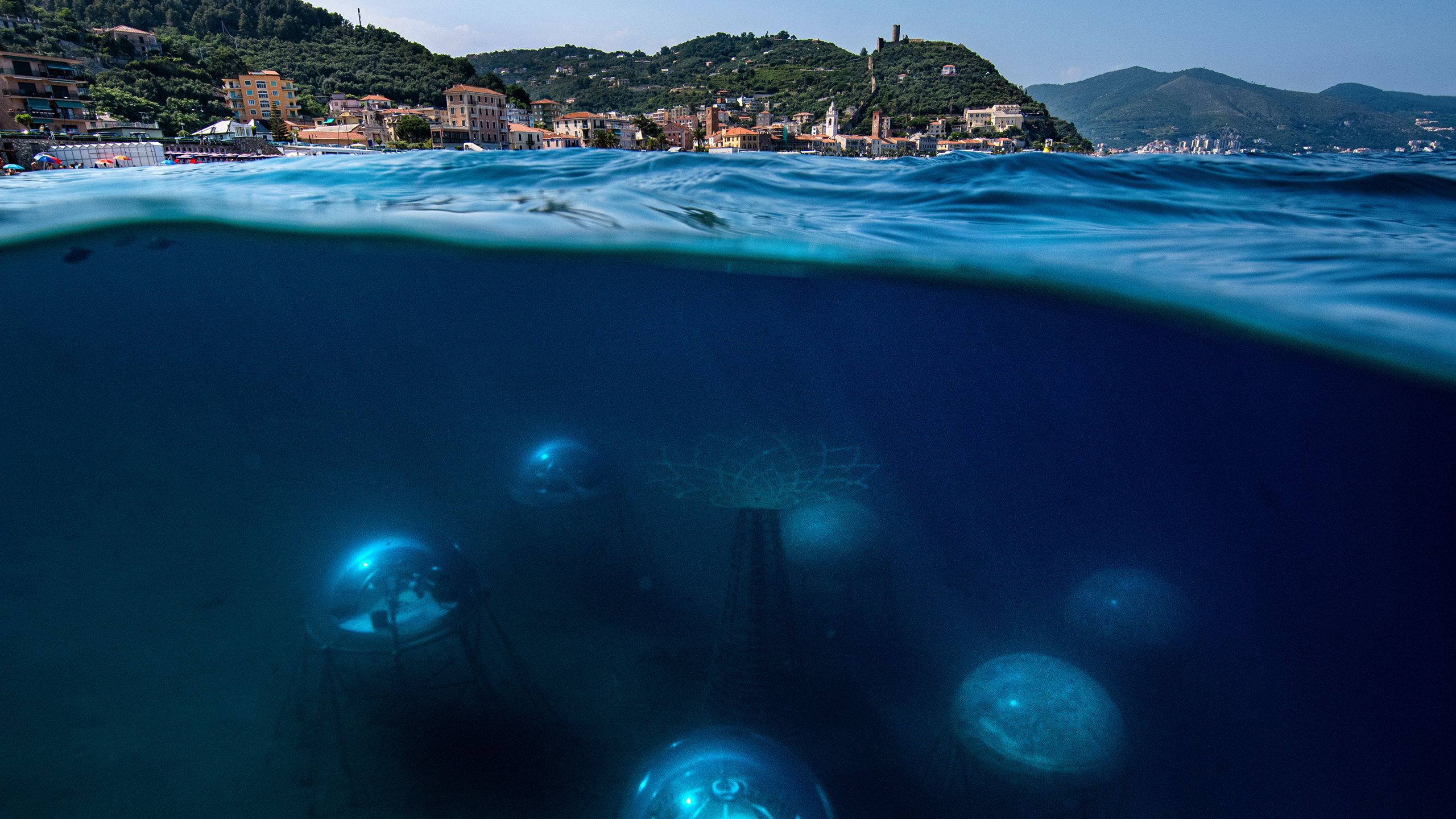Underwater farm and Martian eclipse — April’s best science images
The month’s sharpest science shots, selected by Nature’s photo team.

Nemo’s garden. Forty metres offshore from the village of Noli on Italy’s Ligurian coast, herbs, vegetables and flowers grow in six vinyl biospheres below the sea surface. Nemo’s garden, as the project is known, is an underwater farm started in 2012 to explore the possibility of growing terrestrial plants 6 metres under the sea. This shot, taken by photographer Giacomo d’Orlando, came third in the environment category in this year’s Sony World Photography Awards.

Credit: Dylan Enright/UCR
Credit: Dylan Enright/UCR
Fire-loving fungi. This species of fungus — named Lyophyllum atratum — was found in soil samples after the 2016 Soberanes fire, which burned through redwood forests of Monterey County, California. It is one of several bacterial and fungal species that increased in abundance after the fire, which led to a decline of up to 70% in the number of microorganism species in burnt areas. “It’s not likely plants can recover from mega-fires without beneficial fungi that supply roots with nutrients, or bacteria that transform extra carbon and nitrogen in post-fire soil,” said Sydney Glassman, a mycologist at the University of California, Riverside, in a statement. “Understanding the microbes is key to any restoration effort.”

Credit: Rogan Ward/Reuters
Credit: Rogan Ward/Reuters
Devastating floods. The South African government called a state of emergency after days of heavy rain led to severe flooding and mudslides across parts of the country’s KwaZulu-Natal province. At least 400 people lost their lives in the floods, and dozens are still missing. Collapsed roads and bridges left communities cut off, and thousands of homes were destroyed or damaged. Here, a man walks around a damaged bridge in Umlazi near Durban.
Credit: NASA/JPL-Caltech/ASU/MSSS/SSI. This video has no sound.
Credit: NASA/JPL-Caltech/ASU/MSSS/SSI. This video has no sound.
Martian eclipse. NASA’s Perseverance Mars rover captured this sequence of images of Phobos, one of Mars’s two moons, eclipsing the Sun. Several Mars rovers, including Spirit, Opportunity and Curiosity, have observed Phobos crossing in front of the Sun over the past 18 years. But this is the most zoomed-in, highest frame-rate observation of a Phobos solar eclipse ever taken from the Martian surface. Observing these eclipses allows scientists to measure subtle shifts in Phobos’s orbit over time.

Credit: Ryan Young/Cornell University
Credit: Ryan Young/Cornell University
Mummy mystery. With the help of scans made using a smartphone and open-source technology, archaeology student Carol Anne Barsody is working on a 3D model of a mummified bird that will be included in a multisensory exhibition at Cornell University in Ithaca, New York, in October. The Egyptian mummy had sat in an incorrectly labelled box in the university’s collections for many years. Its provenance is uncertain, but Barsody’s investigations have revealed that the remains are of a male African sacred ibis (Threskiornis aethiopicus) and are between 1,500 and 2,000 years old. This species was often mummified because of its association with death and Thoth, the Egyptian god of wisdom and magic.
Galactic angel. These ‘angel wings’ were created by two galaxies colliding then spewing out dust and gas as they move through space. The system, known as VV689, was observed by the Hubble Space Telescope after being identified during a citizen-science project called Galaxy Zoo. The project relied on hundreds of thousands of volunteers to help astronomers to sort through data from robotic telescopes and to classify galaxies. An ongoing project called Radio Galaxy Zoo is using the same approach to locate distant supermassive black holes.
Credit: ESA/Hubble & NASA, W. Keel; J. Schmidt


Space-like conditions. NASA’s Psyche spacecraft has been put through a series of tests in preparation for its upcoming trip to an asteroid — also called Psyche — that lies in the asteroid belt between the orbits of Jupiter and Mars. The spacecraft is seen here on its way to the vacuum chamber at the Jet Propulsion Laboratory in Pasadena, California, to undergo thermal-vacuum testing to assess how well it can heat and cool itself under conditions that simulate the vacuum of space. The craft is due to launch later this year. It will reach the asteroid in 2026 and will spend 21 months collecting data.
Credit: MBARI. This video has no sound.
Credit: MBARI. This video has no sound.
Deep-sea saucer. This flying-saucer-like species of crown jellyfish has been newly described by scientists at the Monterey Bay Aquarium Research Institute in Moss Landing, California. Atolla reynoldsi is up to 13 centimetres in diameter and has between 26 and 39 coiled tentacles. It was identified while combing through video footage from the bay’s ‘twilight zone’ at a depth of between 1,013 and 3,189 metres. “These remarkable new jellies underscore how much we still have to learn about the deep sea,” the study’s lead author George Matsumoto said in a statement. “On just about every dive into the depths of Monterey Bay, we learn something new.”